During a Crypto Winter, investors tend to stash a portion of their bull market gains in stablecoins to wait out the downturn.
But over the past two months—through Terra's UST stablecoin collapse, panic over a potential bank run at crypto lending company Celsius, and insolvency for crypto hedge fund Three Arrows Capital—that bearish behavior has played out very differently for the two largest stablecoins by market capitalization: Tether (USDT) and US Dollar Coin (USDC).
While Tether’s market cap has lost 19% since the start of May, when it set a new all-time high of $83 billion, USDC has gained 5% and hit an all-time high of $56 billion, according to a Decrypt analysis using CoinGecko data. This means that Tether's supply has been rapidly shrinking since May—a sign that large investors have been cashing out their USDT positions since the market crash—while USDC's supply has increased, suggesting increased demand.
It’s been a remarkably strong run for USDC. Over the past 50 days, Circle’s stablecoin has set a new all-time high 28 times. In fact, it’s done so every day from June 15 until yesterday. On Tuesday afternoon, the gap between USDC and Tether had shrunk to about $12 billion. That’s the smallest it’s been since the fall of 2020.
Now, USDC could pull even with Tether if its market cap grows by roughly 21%—sooner, if Tether continues to lose ground. But this all carries a very serious caveat: It is hazardous, especially now, to assume that an asset’s past performance guarantees what it’ll do in the future.

Stablecoins such as Tether and USDC are generally used by traders to enter and exit trades for other cryptocurrencies, particularly in situations where U.S. dollars are inaccessible and on decentralized exchanges, such as Uniswap. These stablecoins account for a significant percentage of daily trading volume in the crypto market, often surpassing combined volumes for Bitcoin, Ethereum, and the rest of the top 10 coins by market cap.
But since early May, Tether has seen its circulating supply—the coins available to the general public, excluding private sales or coins held by the company—drop by 15 billion. The second week of May, when things were really coming apart for Terra and stablecoins of all kinds were taking heat, Tether holders purportedly redeemed $7 billion worth of the stablecoin for cash after USDT briefly lost its dollar peg.
It could be a sign that investors have lost so much faith in crypto to recover that even stablecoins have started to seem like a risky investment.
Tether Chief Technology Officer Paolo Ardoino, however, had said it demonstrates that the company is able to handle these kinds of redemptions “without the blink of an eye.” Tether appears to have paid out another $8 billion in redemptions since then. But there has been some controversy over whether $4.5 billion sent to crypto exchange Bitfinex yesterday was burned, meaning it was taken out of circulation because it was redeemed for cash, or simply moved to Tether’s sister company.
Paolo is claiming that the 4.5 billion USDT tokens sent to Bitfinex were burned and not moved.
But the blockchain shows that they were actually moved to Bitfinex
Please consider what is wrong with this accusation. pic.twitter.com/B3jm6YxBzx
— Paperhand 🔥 (@philnick567) June 20, 2022
A Tether spokesperson told Decrypt that the stablecoins 24-hour volume, $48 billion compared to USDC’s $5 billion at the time of this writing, is a sign that it has more utility than its competitors and said its falling market cap is proof that its reserves are liquid enough to handle cash redemptions.
“For example, rather than catering to the traditional banking industry, Tether is focused on being the most used currency for peer-to-peer exchanges, remittances, a tool of freedom and inflation hedge for developing countries,” the spokesperson said in an email. “This is why, while Tether’s marketcap has decreased due to the billions of cash redemptions that we've effortlessly facilitated over the past several weeks, Tether’s 24 [hour] trading volume remains roughly 10x that of its closest competitor.”
Circle, the consortium that issues USDC, did not respond to Decrypt’s request for comment.
While USDT and USDC aren’t without competition, they are easily the most dominant in the stablecoin category. Their combined market caps on Tuesday represent 79% of the total $155 billion stablecoin market cap, according to CoinGecko. The third-largest stablecoin, Binance USD (BUSD), has a market cap of $17 billion.
At the start of the year, Tether’s market cap of $78 billion, almost double USDC’s $42 billion, according to CoinGecko. It hardly needs to be said that a lot has changed for USDT and USDC, the third- and fourth-largest cryptocurrencies by market cap, behind Bitcoin and Ethereum.
In early May, when Terra's UST stablecoin had lost its peg, there was a rush to draw a line in the sand between algorithmic stablecoins, like UST, and centralized stables that back their coins with cash or cash equivalent reserves, like USDT and USDC.
“Tether holders should feel very secure that Tether will hold its peg since it is dollar backed and market forces do not affect it,” Tether co-founder Reeve Collins told Decrypt in an email on May 10, when things were starting to look bad for TerraUSD. “I wouldn't be surprised to see an increase in holders of algorithmic stablecoins start to move their money into asset backed coins like Tether."
Two days later, the panic over the UST meltdown intensified and Tether briefly dropped to $0.95, according to CoinMarketCap data, before regaining its 1:1 peg with the U.S. dollar.
The same day, Dante Disparte, Circle’s chief strategy officer, published a blog post that appeared to take a victory lap at the expense of what he called “instruments masquerading as stable.”
“If you want to reference the dollar and create price parity fighting buyer’s and spender’s remorse, you actually need to hold high quality liquid assets (HQLAs in banking parlance) that are dollar denominated and inside the regulated banking system,” he wrote.
USDC made it through the Terra crisis without falling below $0.99. But it did briefly lose its peg last Monday, a day after Celsius announced that it had frozen accounts, when it fell to $0.97, according to CoinGecko.
Last week, Tether put out a statement to dismiss what it labeled “false rumors” regarding the portion of its cash reserves that are being held in corporate paper, or debt owed to it by institutional borrowers. Tether took some heat for having a sizable portion of its cash reserves in commercial paper last year.
In September 2021, Chinese real estate developers Evergrande and Kaisa were at risk of missing a U.S. dollar bond payment—the type of commercial paper that made up $30.6 billion of Tether’s $69 billion reserve at the time.
Since then, the company said it reduced its commercial paper holdings even more. In an assurance report, the company’s accounting firm said commercial paper and certificates of deposit represented roughly one-fourth of its $82 billion reserve on March 31, 2022.
Last week’s statement also attempted to put some distance between Tether and crypto lender Celsius, which has been trying to stave off a bank run, and potentially insolvent hedge fund Three Arrows Capital.
The statement said Tether has “zero exposure to Celsius apart from a small investment made out of Tether equity in the company.” It also said that it has no “lending exposure to Three Arrows Capital,” which has been struggling to work out terms with its creditors to avoid liquidations. Co-founders Kyle Davies and Su Zhu told The Wall Street Journal that they lost $200 million when Terra cratered in May. At one point it managed an estimated $10 billion, but had about $3 billion under management as of April.
Rapidly changing markets, good or bad, have been illuminating for the two largest stablecoins.
The gap between the Tether and USDC was the widest it’s ever been last year, on May 17, 2021, with USDT at a $59 billion market cap, almost four times that of USDC’s $17 billion, according to CoinGecko.
May 2021 was the start of a tumultuous period for crypto markets, which would eventually see the global crypto market lose 9% over 24 hours on May 23, 2021.
At the time, a string of bad news was about to batter crypto prices: Tesla CEO Elon Musk announced the company would stop accepting Bitcoin; top cryptocurrency exchanges, including Binance and Coinbase, suffered outages; and regulators in China were starting to ramp up efforts to shut down Bitcoin mining operations across the country.
A week later, on May 23, 2021, Tether’s market cap was virtually unchanged, but USDC had added $4 billion to its market cap. Tether was still far and away the largest stablecoin, but over the course of a week it had gone from having USDC beaten by a factor of four to a factor of three.
For as long as both stablecoins have existed, Tether’s market cap has usually been several times larger than USDC’s. But that's now changed—and potentially for good.

